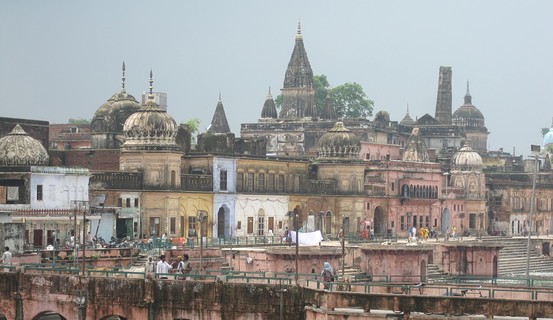Ayodhya is an ancient city of India located in Uttar Pradesh. This is the most sacred place to the Hindus as it was the birth place of Lord Rama. Lord Rama is 7th incarnation of Lord Vishnu. This was founded by Manu. He was the first man in the Vedas. According to Ramayana this place is 9000 years old. At the time of Lord Rama’s rule, this place is known as Kaushaldesa. Atharvana Veda described this place as city built by Gods being prosperous like Paradise itself. Apart from Hinduism influence of Islam, Buddhism and Jainism can be seen in Ayodhya. In this city five Thirthankars were born.
What to see in Ayodhya:
Ramkot: This is the main worship place of Lord Rama. Ram Navami celebrates on the occasion of Lord Rama’s birthday very grandly. This comes between March and April.
Hanuman Garhi: It is situated at the heart of Ayodhya. Visitors can see shrine of Goddess Anjani with Hanuman in her lap. It is believed that cave used to be residence of Hanuman and he guards Ramkot.
Swarg Dwar: Lord Rama was cremated in this place.
Kanak Bhawan: In this Bhawan, visitors can find most beautiful images of Lord Rama and Sita wearing crowns made up of Gold. This Bhawan is also known as Sone Ka Ghar which means house made up of gold.
Treta Temple: This was built at the place where Lord Rama performed Ashwamedha Yajnam. 300 years ago, Raja of Kullu constructed a new temple at this site. In 1784 this temple was renovated by Ahalyabai Hokar. During the time of renovation, adjoining Ghats were built.
Mani Hill and Sugriv Hill: Ancient stupa situated in Mani Hill. This was built by king Ashoka. Surgiv hill has an ancient monastery.
Nageshvarnath Temple: This was built by Kush son of Lord Rama. People say that Kush lost his arm band in Saryu River. This was found by a Naag Kanya. She fell in love with him. In the honour of Naaga Kanya and her devotion towards Lord Shiva, Kush built this temple. All other structures ruined. Only this temple stands still. On seeing this temple itself Vikramaditya found Ayodhya. Shivaratri festival celebrates grandly.
Other attractions of Ayodhya: Other attractions of Ayodhya are Sita ki Rasoi, Ram ki Paidi, Mani Parbat, Ramjanamabhoomi, Babri Mosque.
What to see around Ayodhya:
Faizabad: It is located 7kms away from Ayodhya. This was developed by Safdaejung about 220 years ago. He was second nawab of Awadh. This place is famous for Chotta Calcutta fort. Major attractions of this fort are Jawahar Garden, Moti Mahal, Khrushid Mahal, Gulab Bari.
Gonda: This town is famous for Devi Patan Temple. A tank can be seen here. People believe that this was built by king Karna who was the son of Lord Sun. He built this tank to honour his father lord Sun. It is located 50kms away from the city.
Other attractions near Ayodhya: Other attractions near Ayodhya are Mausolum of Bahu Begum, Rishabhdev Rajghat udayan, Gulab Bari, Guptar Ghat, Raja Mandir, Military temple, Faizabad Musuem, Tulsi udyan.
Getting to Ayodhya: Ayodhya is well connected through road and railways. From Gonda, Gorakpur, Varanasi, Kanpur, Lucknow etc buses and trains com to this place. Nearest airport is located at Lucknow which is 150kms away from the city.
Getting around Ayodhya: Buses, Jeeps, Taxis and autos are available to visit the surrounding place of Ayodhya.
Best time to visit Ayodhya: Best time to visit Ayodhya is between November to March.
Where to stay in Ayodhya: only budget and midrange hotels are available to stay in Ayodhya. Best budget hotels are located near railway station and Ambedkar Nagar. Two government run guest houses are also available.
Where to eat in Ayodhya: Limited restaurants are available to eat in Ayodhya. Available restaurants offer Chinese, Punjabi and North Indian cuisines. Restaurants offer only vegetarian.

